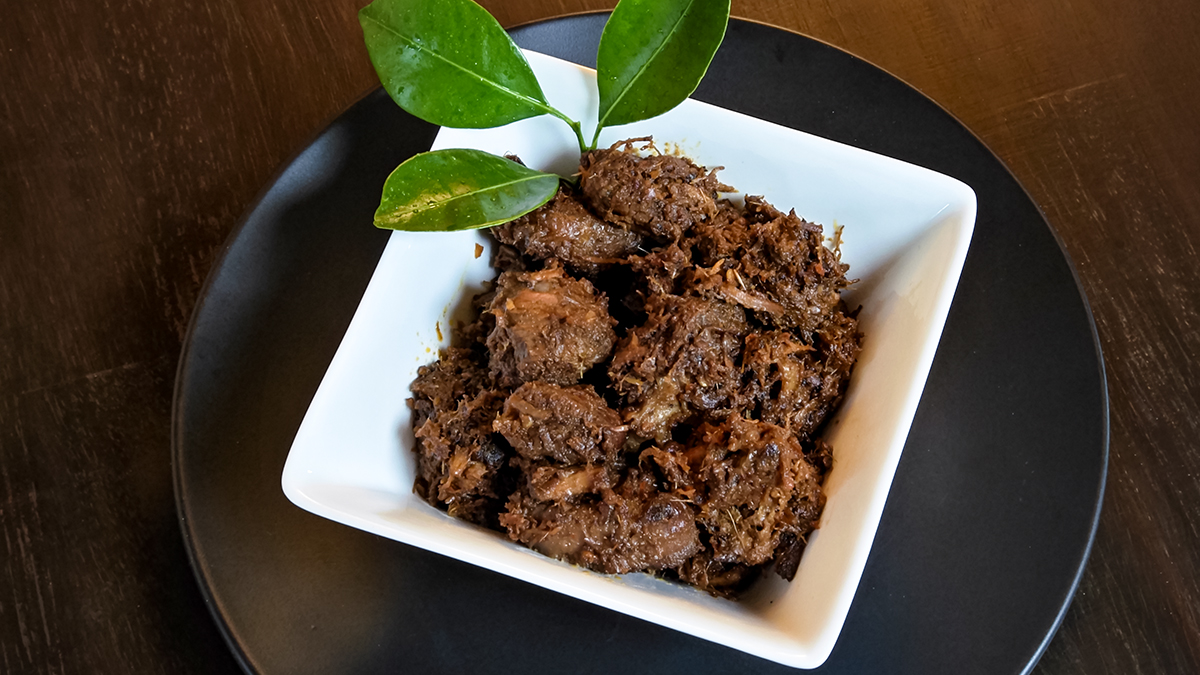|
The
rendang is:
"A spicy, aromatic dish originating from West Sumatra, Indonesia with
different versions across SE Asia.
This dish features a wide range of spices, a lot of coconut (both grated
and toasted, and the cream/milk), a very slow, long cook to caramelize
and turn the dish from its starting bright color to a dark brown,
resulting in a tasty dry dish of tender meat. In a 2011 online poll by
CNN International of some 35,000 people, nominated beef rendang as the
world's most delicious dish (out of a list of 50) ("World's
50 most delicious foods". CNNGo. Cable News Network. Last
retrieved 24 Feb 2021). In 2018, rendang was recognized as one of
five national dishes of Indonesia.
I previously wrote-up my
method for a beef rendang dish (http://clemkuek.com/photoalbum/photo696_3o.html).
This was a no-stir method where all the ingredients are added at the
start into a casserole dish and baked. It is also a Malaysian recipe.
Malaysian rendangs differ from those from Indonesia. In the
latter itself, there are also local variations. In the main, the
Indonesian rendang has fewer spices added to it than the
Malaysian rendang. I wanted to try a representative Indonesian
rendang and for that purpose, one can't go past Indonesian chef William
Wongso. Here is his recipe which I used today (with my variations
noted):
|
-
Adjust the quantity of chill
to suit your taste. The quantity stated by Wongso seems a lot (150
g) even if it is of fresh chillis (my guess). I used 25 g of
de-seeded dried chillis which even then, gives a rather spicy result.
-
Cube the beef into large chunks
and place in a lidded baking container.
Metal Dutch ovens (preferred) or ceramic casserole dishes (my
choice) may be used.
-
Coat the beef with the
aromatics paste.
-
Add two large stalks (30 g) of
lemongrass, and 4 lime leaves (preferably kaffir lime).
-
Add 2 g of tamarind.
-
Add coconut milk or cream.
Wongso states 1.5 L, which seems a lot.
I used 600 mL of coconut cream.
My guess is that the quantity of coconut milk/cream needed really
depends on how thick the coconut extract is - the creamier it is,
then the lesser is the amount needed.
-
Add salt to taste.
Remember that the amount of liquid will reduce and that it is best
to under salt at this stage - you can add more towards the end of
cooking.
-
You may choose to add some
sugar to taste, in the Thai fashion of offsetting the heat of the
chillis.
Add sugar with the same precaution about the amount of liquid
reducing during cooking.
I used a tablespoon of palm sugar.
-
Lid the container and place in
an oven at between 85 and 95°C.
Baking the preparation makes the dish a casserole (it means a
dish which is baked in an oven).
-
Bake for three hours. Stirring
occasionally to evenly distribute the cooking.
-
After three hours, retrieve from
oven and place in a wide pan.
-
Slow fry the beef until the
sauce is as dry as you would like (rendang is usually quite
dry).
The dish should look quite dark brown when ready.
Wongso is adamant that a good rendang requires caramelization
of the sauce - this only happens through heating to the right
minimum temperature and long enough for sugars to undergo
molecular change.
Do not let the dish go black - it will be over-done at this stage
and the rendang will taste bitter.
-
At the end, your rendang
should look like this:
|
